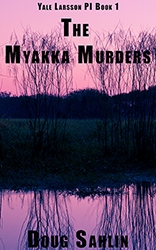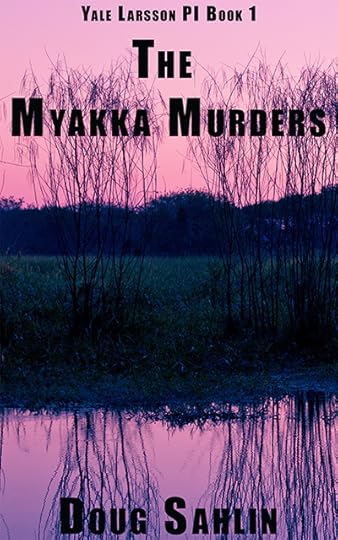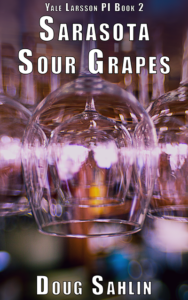Doug Sahlin's Blog, page 4
February 4, 2020
Write What You Know
 I learned a lot from Ernest Hemingway. One of his sage pieces of advice is: “Write what you know.” When I needed a location for my first mystery novel, The Myakka Murders, I chose Myakka River State Park. Why? Because I’ve spent hundreds of hours in the park, photographing the landscape and wildlife. Am I an authority on Myakka State Park? No. But I know more about the area than most casual visitors. I know enough about the park to describe it in detail The following image is the area where Yale’s father was found with one arm missing; the handiwork of a hungry gator.
I learned a lot from Ernest Hemingway. One of his sage pieces of advice is: “Write what you know.” When I needed a location for my first mystery novel, The Myakka Murders, I chose Myakka River State Park. Why? Because I’ve spent hundreds of hours in the park, photographing the landscape and wildlife. Am I an authority on Myakka State Park? No. But I know more about the area than most casual visitors. I know enough about the park to describe it in detail The following image is the area where Yale’s father was found with one arm missing; the handiwork of a hungry gator.

January 21, 2020
Weaving New Threads into an Old Tapestry
A story is like a tapestry. The author weaves in characters, plot points, red herrings, intrigue, mystique and all the other elements that keep readers turning the pages ’til the end. But there comes a point when as an author, you realize you need to add more to the story.
This realization came to me on the 5th pass of the book I’m currently writing. The story was compelling, but I thought it needed more to be ready for my readers. I discussed the situation with my girlfriend Rene��. She had read the current draft of the book, and came up with an excellent solution. So now I’m weaving the new threads into the old tapestry.
It was a major change with existing characters. So my job was to decide where to weave the new plot point into the story. Once I decided where to add a new twist to the book, my next job was to make the change seamless. So far I like what I’ve done and think my readers will as well. One more pass, and the book will be ready to publish. Stay tuned.
Doug Sahlin: Author of The Myakka Murders
January 9, 2020
The Start of a Mystery
I was summoned to the scene of a crime by Sarasota County Sheriff’s Office Deputy Janet Brown. I had no idea why I was needed until they asked me to identify a body with one arm missing found floating in the Myakka River. ��The body was that of my estranged father, Yale Augustus Larsson Sr. This is where the mystery started.

The mystery deepened when one of my father’s associates was found dead not far from this idyllic scene. To find out more, read The Myakka Murders, Yale Larsson PI Book 1 by Doug Sahlin.
December 19, 2019
Yale Larsson Private Investigator Rules
The PI business is tough. Sometimes very tough. To be a good PI, you’ve got to think on your feet and react, sometimes very quickly. To quote an old cliche, “If you snooze, you lose.” In the PI business, loss can be fatal. I almost lost my life when I was a homicide investigator for the Sarasota County Sheriff’s office. A good PI lives by a code and a set of rules. One of these days, I’m going to write a book on being a world class private investigator.
Here are a few of the rules I live by to be a world class private investigator, and to live to a ripe old age.
Yale Larsson Private Investigator Rule Number 21: When in doubt, always err on the side of paranoia.
Yale Larsson Private Investigator Rule Number 27: Never to get between two ladies when they disagree.
Yale Larsson Private Investigator Rule Number 56: Always sit with your back to the wall when you’re in public.
Yale Larsson Private Investigator Rule Number 73 is the same as the Boy Scout Motto: Be prepared.
Yale Larsson Private Investigator Rule Number 69: He who speaks first loses.
To see me use these rules in the heat of action, read a copy of Doug Sahlin’s The Myakka Murders where I solve the mystery of who killed my old man and unceremoniously dumped him in the Myakka River. Can you say, “Gator Bait?”
December 14, 2019
Reading
Read lots of books. And read often. Read books from the genre you write. Think of this as eduction. When you read good books, you learn the craft of writing. From the wordsmiths who write the books you read, you learn how to string sentences together to flesh out scenes, complete chapters, and finish novels
���If you don���t have time to read, you don���t have the time (or the tools) to write. Simple as that.��� Stephen King
December 10, 2019
Elmore Leonard’s Ten Rules of Writing
Elmore Leonard was a prolific author who wrote many best selling novels including Punch Drunk, Get Shorty and Maximum Bob, some of which were made into movies. I enjoyed many of Elmore’s novels. He came up with Ten Rules of Writing, which I follow. I’d like to share them with the readers of my blog.
Elmore Leonard’s Ten Rules of Writing
Never open a book with weather.
Avoid prologues.
Never use a verb other than “said” to carry dialogue.
Never use an adverb to modify the verb “said”���he admonished gravely.
Keep your exclamation points under control. You are allowed no more than two or three per 100,000 words of prose.
Never use the words “suddenly” or “all hell broke loose.”
Use regional dialect, patois, sparingly.
Avoid detailed descriptions of characters.
Don’t go into great detail describing places and things.
Try to leave out the part that readers tend to skip.My most important rule is one that sums up the 10.
*****************************************************************
My summarization of Elmore’s Ten Rules is to let action and dialog carry your story. Show the action to your readers, don’t tell them what they should feel. When an author does his job right and remains invisible, readers will draw their own conclusions.
December 4, 2019
Populating Your Novels
Be on the lookout for characters everywhere you go. Find inspiration for your main characters and your supporting cast using keen observation. Your characters will be a conglomerate of people you know, people you meet, and people you observe. The people in your stories should be real and believable, not cardboard cutouts. If your character is a walk-on, all you need is a brief description. If the person you are describing is a key player in your novel, in addition to describing the character ���the way he looks, dresses, and talks��� you also need to show emotions.
When you see someone who piques your curiosity, a potential character for your next story or novel, in your notebook, jot down as much information as you can to refresh your memory when you start writing. Most writers have another tool that can be used when encountering an interesting person: a cell phone camera. After all, a picture is worth a thousand words. And as wordsmiths, we paint a picture with words for our readers. With a photograph as a reference, you’ll be able to accurately portray a character.
The following images were photographed during a recent trip to New Orleans. These will definitely be used to describe one or more characters in an upcoming story.






Another Caper Solved
Not too long after I brought my father’s killer to justice, I was plunged headlong into another mystery. While visiting my good friends Jurgen and Jutta Becker at their vineyard in Myakka, their sommelier was found dead. When Homicide Detective Kennedy and Sarasota County Medical Examiner Vijay Patel arrived, the body was missing. Hard to solve a murder mystery when the body is MIA. The conundrum will be solved in Doug Sahlin’s novel, Sarasota Sour Grapes, which will be available soon at Amazon.

December 2, 2019
Finding Characters for Your Stories
You���ll find potential characters for your books everywhere you go; the snotty waitress in the restaurant you���ll never dine at again, the street artist wearing tattered jeans and a paint-spattered tee-shirt sketching people in the park or the short-order cook who sings and recites poetry as he fixes your meal. I recently came across a character I���ll use while eating breakfast in Louisiana. He was definitely a coon-ass Cajun. He rambled on about Pavlovian Primates and the maturation of the egg. He quipped to customers standing at the counter that unlike their warranties, his beauty was not transferable.
When you encounter someone who is interesting, jot down the details, but change the person���s name and perhaps gender before using it him in your work.
November 27, 2019
A Writer���s Greatest Gift
While traveling north on I-75 on Sunday morning, I am reminded of the wonderful gift all writer���s have: observation and the ability to turn observations into short stories, novels, or scenes. If a writer is observant, or in the moment, he will be able to receive the gifts every day life has to offer: sunlight leaving dappled shade as it passes through a tapestry of leaves, the symphony of waves gently lapping ochre colored sugar sand punctuated with a sprinkling of seashells, or the tall man in a three-piece suite with a monk ring of hair around his bald pate. As we drive past Ocala, I am reminded of the gas stop we made last year when traversing this very same carpet of macadam. After paying for the fuel, on the way to the gent���s necessary room, a small man strode quickly toward me wearing a police uniform. His hair was cropped close to his head. He smiled and said, ���Good morning.��� I grabbed my notebook���I never leave home without one��� and made this�� simple entry, ���World���s Smallest Cop.��� He will make an appearance in a story yet to be written, perhaps as an ally for Yale Larsson, Private Investigator.



